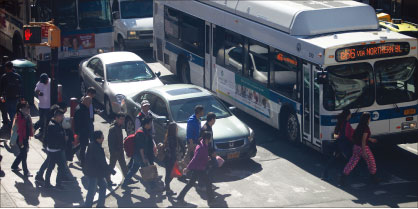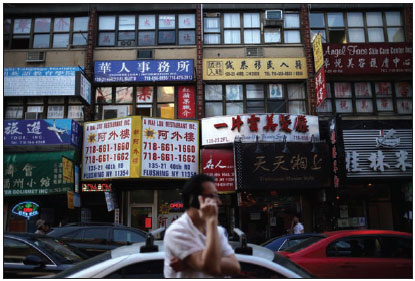Flushing: NYC's 'hot' Chinatown
Updated: 2015-05-15 10:59
By Amy He(China Daily)
|
|||||||||
People who live and work in Flushing sometimes call it 'the Chinese Manhattan'. The city's fastest growing Chinatown is booming - new condominiums, retailers and much more, Amy He reports from New York.
About 45 minutes from Manhattan on the last stop of the No 7 subway is Main Street, the entryway to Flushing, New York City's fastest-growing Chinatown in the last decade.
Throngs of people clog the intersection of Main Street and Roosevelt Avenue, and pack the assorted shops that seemingly offer everything from pork buns and Chinese drinks to cell phone charms.
Store signs in Chinese - and a few in Korean - stack precariously on top of each other, advertising for doctors, accountants, beauty salons and lawyers. The number of Chinese restaurants is endless.
A green neon sign on a health supplement store in English reads: "We Speak Mandarin". Vitamins, fish oil capsules and protein powder are among the most frequently purchased items, says a salesman who explained that some buyers send them to relatives in China. The nearby Western Union also caters to sending money back home. Only cars and city buses move slower than the people on packed sidewalks.
That Flushing is booming beyond the main intersection can be seen - and felt - everywhere in the community of 72,000. The numbers are up for new residents, new housing projects, new retailers and investors, but so are rents and housing prices.
Manhattan's Chinatown is the city's oldest Chinese community, and used to have the most Chinese.
Now Flushing in the north-central part of the borough of Queens is No 1 with 33,536 Chinese, according to the 2010 Census. Of the total population, 69.2 percent are Asian (Koreans are the second-largest Asian group), 14.9 percent Hispanic, 9.5 percent white and 4.2 percent black.
Manhattan's Chinatown population has decreased 17 percent since 2000, from 34,554 to 28,671, according to the Asian American Federation, a Manhattan nonprofit.
Flushing saw a wave of immigration in the 1980s that transformed the community into one of the most diverse in Queens. Today, the greater Flushing area has the third-largest immigration concentration in New York City, according to a 2011 report by the state comptroller.
New condos
New construction for housing has been one of the biggest developments in Flushing. Much higher rents in Manhattan and Brooklyn have caused an influx of Chinese-Americans, as well as new immigrants looking to be close to relatives and empty-nesters downsizing from suburban homes, according to real estate agents, who say wealthy Chinese buyers are investing in rental property.
In 2007, SkyView Parc with 448 units in three buildings became one of the first luxury condo developments in Flushing. It was constructed by Onex Real Estate Partners. Now Onex is developing another three buildings -The Grand at Sky View -with 800 units.
The first building opened in January, and David Brickman, Onex's vice-president, said that within one day half the units were sold. Studios sold for $489,000 to $604,000; one-bedrooms $540,000 to $794,000; two-bedrooms $890,000 to $1.2 million and three- and four-bedroom units began at $2 million. A second building will open in the summer, Brickman said.
"There has been pent-up demand. We've had people living in Brooklyn but are buying in Flushing," he said.
Brickman said buyers and investors like that they can get comparable quality and amenities in Flushing for lower prices than in Brooklyn or Manhattan, where a resurgence in the real estate market over the last few years has bumped up prices.
Brickman and Andrew Gerringer, managing director of new business at the Marketing Directors, which helps developers market their properties, both said the buyers are predominantly local Chinese and paying all cash. There also are buyers from the Chinese mainland seeking investment property or housing for their children who might be studying at a college or university in the New York area.
"It's families buying who have strong ties to the neighborhood," said Gerringer. "I'd say there are more people in the community buying than there are people buying from outside the community."
Elderly Asians are also drawn to Flushing for its conveniences, according to real estate agents and Peter Koo, the New York City Councilman who represents Flushing. Koo was elected in 2009 and has spent three decades living and working in the community. The 62-year-old immigrated to the United States from Hong Kong in 1971.
"We've had empty nesters who live in Long Island and are planning on selling their home and are looking to move back into the city and choosing Flushing over Manhattan because it's where their friends are," said Brickman.
"A lot of elderly people move here, because even if they have children who have big houses in Long Island, or New Jersey, they want to stay in Flushing in a studio. They have their freedom; they can go out and do things," Koo said.
Josh Zegen, co-founder of Madison Realty Capital, said that Flushing attracts foreign interest. "There's just a lot of money from foreign investors, US capital and institutional capital coming into Flushing, as well as other parts of Queens," he said.
"I think Flushing is a very deep market and only getting deeper." Zegen said. "The density is so great and the traffic, if you're a retailer, retail rents are like you wouldn't believe them. But because of the density, they have the foot traffic, you have the business."
Retail rents are about $40 to $50 a square foot, Zegen said, compared to Manhattan's $55 to $75 a square foot, according to figures from commercial real estate service Colliers International.
"That's not a cheap rent," Zegen said. "If you didn't know the office market, you wouldn't guess that Flushing was getting $40-$50 a square foot."
And new retailers are moving into Flushing, taking advantage of rents that are lower and going after the growing population.
Flushing Mall, a fixture in the neighborhood for 15 years that was known for its Asian food court, closed on January 30 to make way for housing and commercial developments. When it opened in 2000, it was the first Flushing mall with businesses run mostly by Chinese, and became a must-visit for locals and tourists.
New retailers
Now SkyView Center, a 700,000-square-foot mall which sits below the Sky View Parc condos, is attracting major retailers. Nike and Forever 21 signed leases late last year for 15,000 and 10,000 square feet of space, respectively. Japanese retailer Uniqlo signed an 8,000-square-foot lease this year for its first location in Queens. All three retailers are expected to open soon.
Target, Nordstrom Rack and Old Navy are other retailers at the mall, which real estate news site The Real Deal said Onex Real Estate Partners is looking to sell for $400 million. Onex declined to comment to China Daily on the report.
"These are big moves by retailers. Flushing is seen as an enclave for the Asian community and a lot of development is coming up," said Michael Lee, senior associate at commercial real estate group CBRE.
"Retailers are looking for nice premium spaces and the Flushing market has been really hot, and now the national retailers are starting to look around," he said. "There are retailers that have been in the area for a while, particularly financial services, and they're fully aware of the great market that Flushing is. Now there are some other retailers trying to understand the Flushing market and trying to break into it."
Zegen said Flushing and Queens are still trading at a discount relative to Brooklyn and Manhattan, but that discount is narrowing. "Queens is picking up quicker than other places because there's so much growth in Brooklyn and Manhattan that we've already witnessed in the last few years," he said, predicting that in the next few years Queens will catch up to Brooklyn and Manhattan.
Michael Chu, owner of travel agency Asian American Global Travel Inc, is one community businessman who has benefited from the rise of wealth in China. He hosts tour groups from the Chinese mainland, as well as from Hong Kong and Taiwan.
"These visitors have helped form an industry chain from hotels and catering to tour guides. A lot of job opportunities and thousands of small business groups have been created. This is inextricably linked with the mother country," Chu said.
"In this climate, because of Chinese immigrants and those coming from the mother country frequently interacting, there have been mutual benefits like capital injection," he said. "The Chinese community is expanding, and the economy here is booming."
On the jobs front, Flushing has seen increases every year since 2005 despite the economic downturn across the city during the financial recession. In 2010, the community added jobs at a rate of 3.1 percent, "far outpacing the rest of Queens and the rest of the city," said the 2011 state comptroller report. The number of businesses grew 37.6 percent between 2000 and 2009 compared to the 5.7 percent city average.
"Flushing is a good example of how immigrants bring up the whole community because they work hard, they persevere. They make sure their kids go to school, so that the second-generation, even if they don't stay in the family business, can go on to work in better professions," said Koo.
Chinese-owned businesses and customers dominate downtown Flushing, which used to be all-white until about the 1970s and then became a mostly Korean enclave before the Chinese became the most-populous ethnic group.
Koo said that in Flushing "everything is more": "There are more banks, more doctors offices, more lawyers offices, more travel agencies. You come to Flushing, you have everything."
New immigrants
The owner of Chung Hwa Bookstore on Roosevelt Avenue, who declined to give his name, said that Flushing is a good area for new immigrants.
"More Chinese come here because it's very convenient for new immigrants. You can speak Chinese, see a Chinese doctor, eat Chinese food," he said. "No vehicles are needed since there are all kinds of transportations available."
A travel agent at the L&L Travel Enterprise said he chose to rent an apartment in Flushing because of the existing Chinese community. "And it's more convenient since all my friends are here," said the agent, whose surname is Chen.
Chen Junjie, a sales agent at United Healthcare, said that Flushing is a fast-growing Chinese neighborhood because of what he said is its "higher quality" over Manhattan and Brooklyn.
Though police at the 109th precinct which covers Flushing declined to comment to China Daily on the level or nature of crime in the community, statistics from the precinct show there have been 438 crimes committed so far in 2015, about 16 percent of the 2,672 crimes committed across all of northern Queens. The citywide total for the week ending April 12 was 24,955 for all five boroughs.
According to the most recent data from the FBI's uniform crime report, for Flushing in 2013 the overall crime rate was 35 percent lower than the national average; for every 100,000 people there were 5.47 daily crimes; a person had a 1 in 51 chance of becoming a victim of any crime; and the community was safer than 64 percent of the cities in New York State.
Children in Flushing attend 26 public elementary schools, seven middle schools and seven public high schools. Total student enrollment for the 2013-2014 school year was 37,279, according to the most recently available statistics.
Koo said Flushing's elementary and middle schools are good, but most students tend to leave the community to attend such specialized high schools as Stuyvesant High School in Manhattan, the Bronx High School of Science and Brooklyn Technical High School.
"Everyone wants to go to specialized high schools, to go outside of Flushing. They don't stay here for school. That's why we have so many openings, and the department of Education sends students from other boroughs to come here," he said.
Elderly Asians are also drawn to Flushing for its conveniences, according to real estate agents and Koo.
Each day hundreds of senior citizens gather at a senior center on 39th Avenue which was launched in 1966 by the Chinese-American Planning Council (CPC), one of the biggest Chinese-based social services agencies in New York.
Cheng Chean Ming, a 75-year-old retiree originally from Taiwan, said he has been a member of the CPC senior center for years. He said that he lives about 20 minutes from the center and comes most days of the week, paying $20 a year in dues.
"I used to be a member at other senior centers in the area, but chose this one because of convenience. It's so close to my house," he said.
Daily lunches at $1.50 are available at the center for members.
The CPC center has gotten more crowded over the years, Cheng said. "Years ago, there might have been a few dozen people here during the day, but now upwards of 200 people pass through these doors every day," he said.
While residents and small business owners can take advantage of the neighborhood's conveniences, they also must deal with the drawbacks that come with a growing population. Foot traffic that makes neighborhood businesses bustle also brings traffic congestion, said Koo and numerous Flushing residents.
Buses are a major source of that traffic, with 19 bus lines coming to Flushing from other parts of Queens. Koo said he is trying to work with city transportation officials to establish a bus depot and to reroute some buses. Last month, Queens borough President Melinda Katz and the city's transportation department announced new measures to alleviate traffic congestion in downtown Flushing.
Fred Fu, a 27-year resident of Flushing and president of the Flushing Development Center, said that people often complain about the traffic and congestion, not realizing that they themselves are causing the problem.
"Flushing is popular now, and people like my sister would come in from Westchester to buy groceries on the weekend, and then complain about how there are so many people and so much traffic," he said. "She doesn't realize that it's people like herself who are contributing to the issue!"
Even though the number of small businesses is increasing, shop owners complain about the increasingly competitive environment and the rising rents.
"Flushing's development is getting better, but doing business is getting more and more difficult," said Tony Mei, a manager at N.J. Jewelry at the New World Mall. "The rent is too high and the city government unreasonably imposes various fines."
Ivy, another shopkeeper in the New World Mall, said that when she arrived in Flushing 10 years ago, the neighborhood was quiet after 6 pm because it was deemed unsafe. Although now the streets are teeming with people at all hours, she also complained about rising rents, saying "maintaining a small business is getting increasingly difficult."
A bookshop clerk at Chung Hwa Bookstore, with the surname Zhang, said that she has seen residential rents go up by $1,000 a year. "Some tenants are even ordered by landlords to pay the land tax besides rent. That's why I don't live here, because the neighborhood is ultra-expensive," she said.
There are residents who take a more optimistic view to the growing population and businesses. A Chinese restaurant cook who goes by the surname Tan said that competition for catering and other business opportunities is increasing, but that "this is the principle of economic development."
The 40-year-old Tan, who immigrated to Flushing just three years ago, said that now that US visa validity has been extended from one year to 10 years even more people will come from China. "I hope Flushing does well and that everybody living here does well too," he said. "The good of this community will be good for everybody."
Contact the writer at amyhe@chindailyusa.com
Hong Xiao contributed to this report.
|
Downtown Flushing is crowded with people as well as bus and car traffic. While Chinese predominate the community, there is a sizable Korean population. Meng Han / for China Daily |
|
Signs on stores give the downtown area the feel of an Asian city. Meng Han / for China Daily |
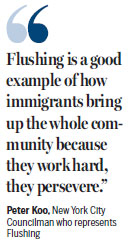
(China Daily 05/15/2015 page20)

 Cannes Film Festival unrolls star-studded red carpet
Cannes Film Festival unrolls star-studded red carpet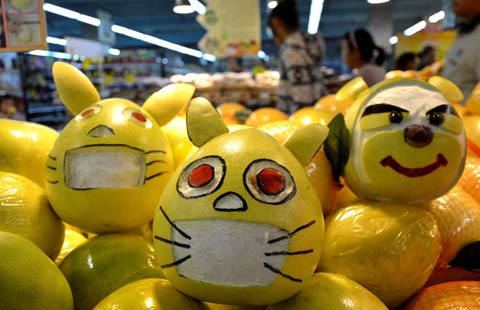
 Amazing artworks in supermarkets
Amazing artworks in supermarkets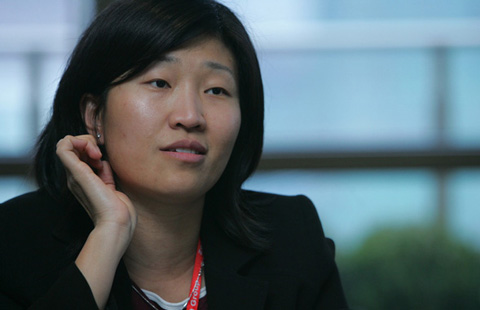
 Top 10 venture investors in the world
Top 10 venture investors in the world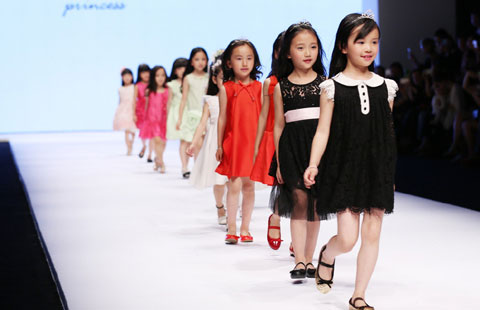
 Ten photos you don't wanna miss - May 14
Ten photos you don't wanna miss - May 14
 Classical private school in Qinling Mountain
Classical private school in Qinling Mountain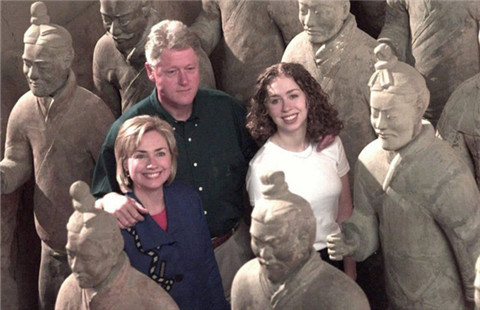
 Heads of state show you around Xi'an
Heads of state show you around Xi'an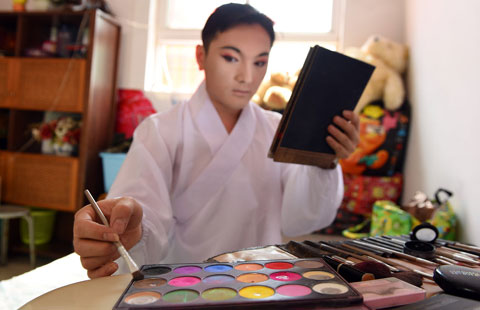
 Cross dressing for Peking Opera
Cross dressing for Peking Opera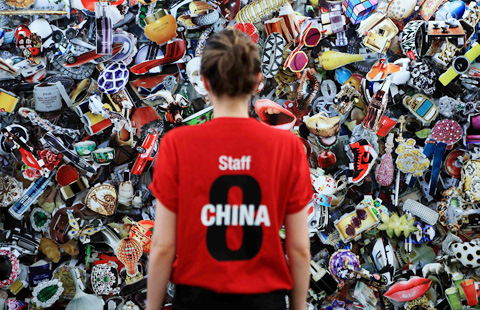
 Ten photos you don't wanna miss - May 13
Ten photos you don't wanna miss - May 13
Most Viewed
Editor's Picks

|

|

|

|

|

|
Today's Top News
Xi to give Modi a hometown welcome
Aviation, railway top Li's agenda for Latin America
Cui rebuffs US stance on
S. China Sea
China set to delay maiden flight of C919 commercial jet
Police warn 'strange outfits' on subway may cause stampedes
At least six die in Philadelphia train derailment, scores hurt
Cui: How to get a win-win in Asia
Animated Deng Xiaoping set to hit silver screen this week
US Weekly

|

|
